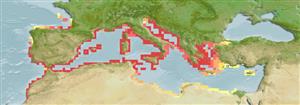>
Eupercaria/misc (Various families in series Eupercaria) >
Labridae (Wrasses)
Etymology: Labrus: Name from Latin 'labrum' for lip, rim or edge; referring to the big lips of the fishes of the genus (from Ovid and Pliny according to Petrus Artedi)..
More on author: Linnaeus.
Environment: milieu / climate zone / depth range / distribution range
Οικολογία
Θαλασσινό(ά) Υφαλόφιλο(α). Subtropical; 48°N - 29°N, 11°W - 43°E
Eastern Atlantic: Portugal to Morocco, and the Mediterranean and Black Sea.
Length at first maturity / Μέγεθος / Βάρος / Age
Maturity: Lm ?, range 16 - ? cm
Max length : 47.0 cm SL αρσενικό/απροσδιόριστο; (Ref. 4742); common length : 37.5 cm SL αρσενικό/απροσδιόριστο; (Ref. 4742)
Adults are found in littoral zone, near rocks and eel-grass beds (Ref. 3666). Oviparous, distinct pairing during breeding (Ref. 205). Males build dish shaped nests and guard the eggs (Ref. 205).
Oviparous, distinct pairing during breeding (Ref. 205). Males build dish shaped nests and guard the eggs (Ref. 205).
Bauchot, M.-L. and J.-P. Quignard, 1979. Labridae. p. 426-443. In J.C. Hureau and Th. Monod (eds.) Check-list of the fishes of the north-eastern Atlantic and of the Mediterranean (CLOFNAM). UNESCO, Paris. Vol. 1. (Ref. 3666)
IUCN Red List Status (Ref. 130435)
Threat to humans
Harmless
Human uses
Περισσότερες πληροφορίες
ΑναφορέςΥδατοκαλλιέργειεςΠροφίλ υδατοκαλλιέργειαςΣτελέχοιΓενετικήElectrophoresesΚληρονομικότηταΑσθένειεςΜεταποίησηNutrientsMass conversion
ΣυνεργάτεςΦωτογραφίεςStamps, Coins Misc.ΉχοιΣιγκουατέραΤαχύτηταΚολυμβητικός ΤύποςΕπιφάνεια βραγχίωνOtolithsΕγκέφαλοιΌραση
Εργαλεία
Special reports
Download XML
Διαδικτυακές πηγές
Estimates based on models
Preferred temperature (Ref.
123201): 17.4 - 20.3, mean 18.9 °C (based on 389 cells).
Phylogenetic diversity index (Ref.
82804): PD
50 = 0.5625 [Uniqueness, from 0.5 = low to 2.0 = high].
Bayesian length-weight: a=0.01148 (0.00708 - 0.01861), b=2.98 (2.84 - 3.12), in cm total length, based on LWR estimates for this species & (Sub)family-body (Ref.
93245).
Τροφικό Επίπεδο (Ref.
69278): 3.9 ±0.4 se; based on diet studies.
Ελαστικότητα (Ref.
120179): Χαμηλό, ελάχιστος χρόνος για διπλασιασμό πληθυσμού 4,5 - 14 έτη (Preliminary K or Fecundity.).
Fishing Vulnerability (Ref.
59153): Moderate vulnerability (43 of 100).
Nutrients (Ref.
124155): Calcium = 25.7 [13.2, 58.8] mg/100g; Iron = 0.562 [0.305, 1.051] mg/100g; Protein = 19.5 [16.7, 21.8] %; Omega3 = 0.243 [0.139, 0.419] g/100g; Selenium = 18.8 [9.4, 36.0] μg/100g; VitaminA = 47.5 [14.5, 196.6] μg/100g; Zinc = 0.715 [0.463, 1.152] mg/100g (wet weight);
